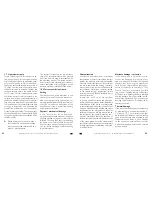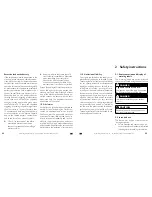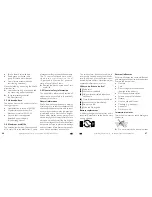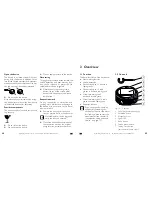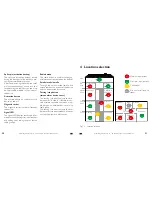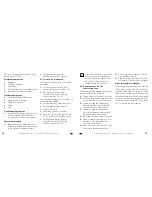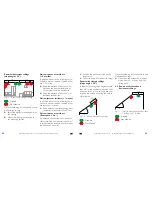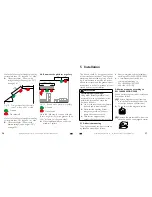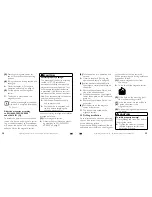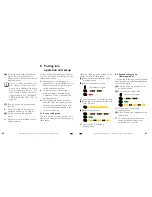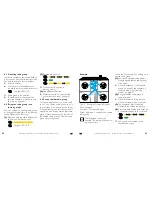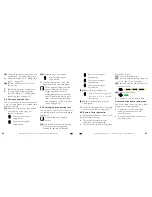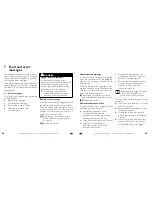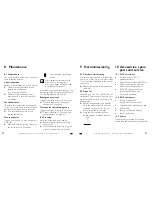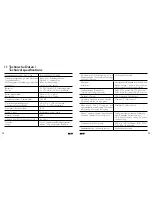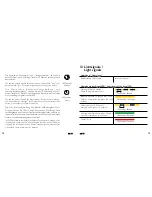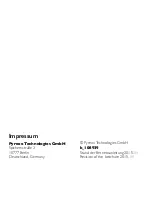
EN
70
Operating Manual: PX-1C - Smoke Alarm Device with Radio Link
Operating Manual: PX-1C - Smoke Alarm Device with Radio Link
EN
71
7.2 Troubleshooting
Problems can occur when putting into
service, installation and operation under
the following circumstances:
•
Devices not or no longer
in the learning mode
•
Radio group not or no longer
in the learning mode
•
No wireless connection, although
the device and the radio group
are in the learning mode
A problem is indicated by the LED light signal
(see chapter 13 „Light signals“ on page 79).
Device not or no longer
in the learning mode
If a device cannot be connected to a radio
group, and its LED signal light does not
flash yellow, it can be that the device is
not or is no longer in the learning mode.
To troubleshoot, proceed as follows:
f
Pull activation button up.
f
Press and hold the
testing / stop
button for 2 to 3 seconds.
f
Bring the device into learning mode
(see chapter 6.2 „Expand radio group
(learning mode)“ on page 61).
f
If required, put device into factory
settings (see chapter 6.8 „Restore
factory defaults“ on page 65), and
extend the radio group (see
chapter 6.2 „Expand radio group
(learning mode)“ on page 61).
Radio group not or no longer
in the learning mode
If a device cannot be connected to a ra-
dio group, and the LED signal lights of the
radio group devices do not flash yellow, it
can be that the radio group is not or is no
longer in the learning mode.
To troubleshoot, proceed as follows:
f
Bring the radio group into learning
mode (see chapter 6.4 „Bring the radio
group into learning mode“ on page 62).
Device and radio group
in the learning mode
Although device and radio group are in the
learning mode and the signal LED flashes
yellow, there may be no wireless connec-
tion. To troubleshoot, proceed as follows:
(1)
Check the distance between the de-
vices; reduce the distance if necessary.
(2)
Put the devices and radio group into
operation again.
f
Restore factory defaults of all devic-
es restore (see chapter 6.8 „Restore
factory defaults“ on page 65).
f
Put the devices and radio group into op-
eration again (see chapter 6 „Putting into
operation and setup“ on page 60).
Defective connection test of
a radio group
A defective device can be identified within
a radio group by “group connection test"
(see chapter 6.6 „Group connection test“
on page 64). If a faulty device is identi-
fied, proceed as follows to troubleshoot
f
In order to exclude a temporary
radio interference from other
radio-based devices, perform group
connection test on another device.
5
Connection test was successful and
all devices are operational.
or
5
Connection test was not successful,
there is a defective device in the radio
group.
f
Reset the defective device to the fac-
tory settings (see chapter 6.8 „Restore
factory defaults“ on page 65).
f
Cancel defective device from the radio
group (see chapter „Cancel a device
from a radio group“ on page 65).
f
Re-connect radio group with a
reduced number of devices (see
chapter „Cancel a device from a radio
group“ on page 65).
To add a replacement device to the ra-
dio group, refer to the following chapters:
f
Chapter 6.4 „Bring the radio group
into learning mode“ on page 62.
f
Chapter 6.2 „Expand radio group
(learning mode)“ on page 61.
f
Chapter 6.3 „Finalising radio group“
on page 62.

